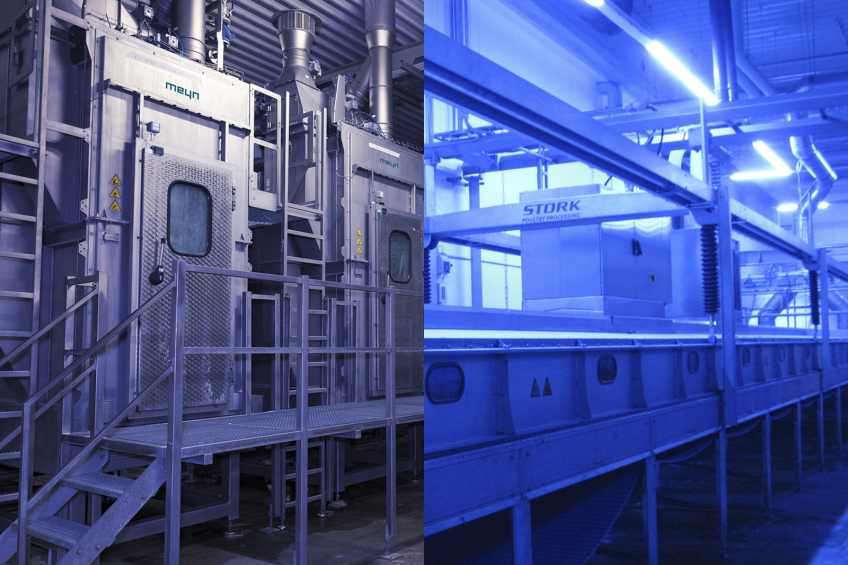CO2 stunning for poultry – worldwide interest

Globally, the interest in CO2 stunning systems for poultry is growing, in particular those with a five-six minute CO2 recipe. Meyn Food Processing Technology, Marel Stork and a Wageningen scientist give their views on the latest developments.
There are two types of stunning systems commercially used for poultry, a water bath system and controlled atmosphere stunning with CO2. Worldwide the water bath stunning system is the most used system. Since 1st January 2013 the new EU legislation 1099/2009 has been in place. The new legislation protects animals at the time of killing and describes in detail what and how systems must be used for stunning and killing animals. For water bath stunning systems minimum currents (mAmp) per bird are determined. Currents that are required to ensure loss of consciousness in all birds cause quality loss of the meat. This is one of the reasons why the majority of European processors have already switched to a two phase CO2 stunning system.
One of the companies that provides such a system is Meyn Food Processing Technology BV from Oostzaan, the Netherlands. According to Wouter Veerkamp, Poultry Processing Researcher: “Meyn has closely followed the development of CO2 stunning systems that have been developed since the 1990s. Because, the first generation CO2 stunning systems didn’t meet the Meyn criteria. That’s why we have done a lot of research to the development of a new CO2 stunning system.”
In doing so, Meyn decided in 2009 to work together with the American company Praxair. Veerkamp adds: “We found during our research that Praxair had the best CO2 recipe and in co-development we created a new multi-stage CO2 stunning system. A lot of attention was given to animal welfare in the process. As the birds remain in the drawer or container during stunning, the handling and transport of active birds is completely eliminated. This largely reduces handling stress and thus risk of injuries to the birds. The closed cabinet construction allows for the CO2 concentration to be managed perfectly in every stage of the process and auto calibration at the beginning of every cycle. This ensures a very humane stun that has been validated by several international welfare experts, scientists and improves product quality. In the Meyn CO2 stunning system one recipe is used for all types, sizes and weights of birds. The Meyn multi-stage CO2 stunning system forms an integral part of the Meyn live bird handling systems. Both new as well as existing configurations can be extended with this innovative stunning system.”
Increasing interest in CO2 stunning systems
The CO2 used for CO2 stunning systems is not produced at the processing plant. It is often a residual product from the steel or chemical industry. CO2 stunning therefore doesn’t add CO2 to the atmosphere itself. However, in some parts of the world or locations CO2 is difficult to obtain and the distance to a source that is too far increases the cost significantly. Meyn knows that more and more countries in the world are interested in the multi-stage CO2 stunning systems. For example, Australia, Russia, America, Canada and South American countries. The reason is that in these countries animal welfare and no live bird handling is becoming more and more important. Also at trade shows, like IPPE 2016 in Atlanta and Agroprodmash 2015 in Moscow, CO2 stunning was a major topic.
CO2 stunning system – most animal-friendly technique
A Dutch senior researcher who has a lot of knowledge about gas stunning systems is Marien Gerritzen of Livestock Research at Wageningen UR, division of Animal Welfare. He is also a Dutch representative in the Scientific Contact Point of the European Union. Since 1996 he has been participating in the research of the two phase anesthetic system. “Results of this research showed that the two phase CO2 stunning system is the best way of CO2 stunning. If you look at the whole stunning process, including shackling, it is also an animal-friendly system. Glasgow University and Bristol University in England came to the same conclusion.”
According to Gerritzen various atmosphere stunning systems are available worldwide. “The Marel Stork system gently unloads the broilers onto a trampoline-like belt which transports them to the stunning system. Then they are exposed to less than 40% CO2 for one minute after which the CO2 level is slowly built up to a higher percentage. At Meyn Food in terms of stunning mechanism the same process is applied, only in that case the chicks go, along with the transport container, in the stunning device in which the CO2 concentration is built up gradually in more steps.” One minute of 40% CO2 is, according to the senior researcher, enough to stun the animals, which is fully evidenced by extensive scientific research. According to Gerritzen, it is very important that the CO2 percentage is built up slowly. “Otherwise the product quality loss will be too high due to rapid muscle convulsions.”

LAPS – Low Atmospheric Pressure Stunning
In the UK, according to Gerritzen, the gas stunning technique was often applied with a nitrogen/argon recipe, mainly because argon was easy to get in this country. “The operation was similar to that of CO2-anesthesia but had the disadvantage of severe muscle convulsions and therefore quality loss. That is why UK slaughterhouses now add CO2 to temper the quality loss.” Currently, the American stunning system LAPS (Low Atmospheric Pressure Stunning) goes through the approval procedure of the European Food Safety Authority (EFSA). LAPS gradually lowers the air pressure in the cabin where the broilers are located so that they can inhale less oxygen. Gerritzen says, “I don’t know the purchase price of this system, so I can say little about it, compared to the CO2 stunning installations. One advantage is, in any case, that you don’t need CO2 or another gas.”
Currently, the EU has the most stringent requirements in force concerning stun devices. In other countries worldwide the requirements are slowly becoming stricter. Gerritzen: “I think the technique of water bath stunning will endure in the long run, because it is by far the cheapest way. It may be that in some countries stricter legislation will result in a faster introduction of gas stunning systems, such as CO2-stunning. I expect, however, that the improved product quality yield of CO2-anesthesia will be the main stimulus to switch eventually.”
Stunning poultry – ccience as a basis
The world’s first Controlled Atmosphere Stunning (CAS) system for poultry was produced by Marel Stork Poultry Processing BV, located in Boxmeer (the Netherlands). “Based on intensive research in the early 1990s, we launched the first generation CAS stunning system in 1996. Our latest generation stunning system, the CAS SmoothFlow, is the result of three decades of research as well as customer and market experience,” says Tim van Schaik, product specialist live bird handling at Marel Stork. In the last 30 years several universities worldwide researched the topic of atmosphere stunning.

“We have co-operated with numerous research institutes worldwide such as the Roslin Institute of the University of Edinburgh,” says Van Schaik. “The technology we apply is supported by dozens of scientific publications.” Unique to the Stork CAS SmoothFlow system is the regulated addition of O2, next to CO2. Van Schaik: “Based on the findings of scientific research, we use CO2 and O2 together to form an optimum mixture for the broilers to get smoothly induced into unconsciousness.” The SmoothFlow system can consist of up to five equal sections, each with its own programmable controlled atmosphere. In the induction phase the broilers lapse gently into unconsciousness. Perfect control over the air mixtures in subsequent sections ensures a smooth transfer to the completing phase.
First-in-first-out principle
The Stork SmoothFlow system processes poultry according to the first-in-first-out principle. Van Schaik: “As a result of the straight inline setup, the continuous process assigns the same stunning time and atmosphere level to every broiler. Another advantage of this linear setup is the removal of DOA’s (dead on arrival) before they enter the stunning process.” Some countries and regions don’t accept DOA’s entering into the stunning device.
Just like Veerkamp stresses, Marel Stork’s system specialist confirms that hanging stunned broilers is the biggest differentiator of atmosphere stunning compared to water bath stunning. Van Schaik adds, “Looking through windows along the entire tunnel, we can check the broilers’ behaviour during the inline stunning process. The new generation Marel Stork systems stun the broilers within five minutes; atmosphere stunning results in an irreversible anaesthesia.”
Also Marel Stork sees an increasing global interest in atmosphere stunning systems. According to Van Schaik, many aspects are involved when opting for water bath or atmosphere stunning. “Various considerations have to be taken into account, such as animal welfare, food safety, regulations, hygiene, religious requirements, and product quality. Besides that, atmosphere stunning systems have larger footprints than water bath stunning systems, so available space can be a decisive argument. Our customers choose CAS stunning or water bath stunning with different needs and priorities in mind. It’s our mission to offer the solution which best fits their situation.”












